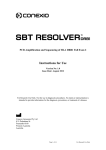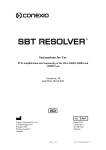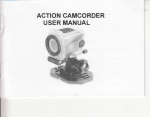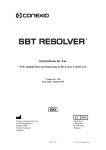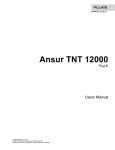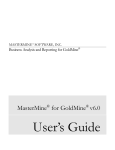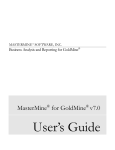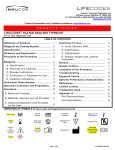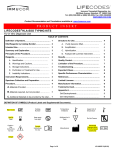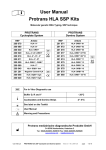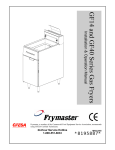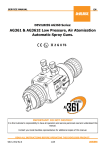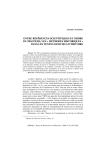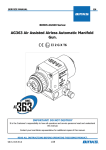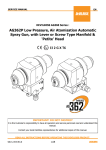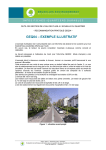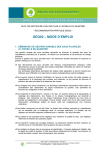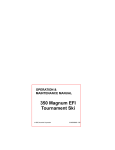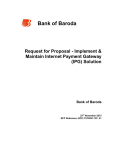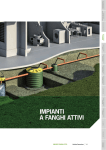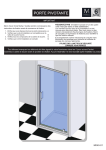Download EU - Conexio Genomics
Transcript
Instructions for Use Version No: 6.0 Issue Date: August 2015 EC Conexio Genomics Pty Ltd 2/49 Buckingham Dr Wangara 6065 Western Australia Australia REP Qarad bvba Cipalstraat 3 B-2440 Geel Belgium Page 1 of 14 For In-Vitro Diagnostic Use PRINCIPLE ............................................................................................................................................ 3 INTENDED USE .................................................................................................................................... 3 KIT COMPOSITION ............................................................................................................................ 4 STORAGE REQUIREMENTS ............................................................................................................. 4 MATERIALS, REAGENTS AND EQUIPMENT NOT SUPPLIED ................................................. 4 SAMPLE REQUIREMENTS ................................................................................................................ 5 WARNINGS AND SAFETY PRECAUTIONS ................................................................................... 5 SYMBOLS .............................................................................................................................................. 6 PROCEDURE ......................................................................................................................................... 6 1. 2. 3. 4. HARPS® SEQUENCING REACTION .............................................................................................. 6 PURIFICATION OF SEQUENCING REACTION PRODUCTS................................................................ 7 DENATURATION & ELECTROPHORESIS OF SEQUENCING REACTION PRODUCTS .......................... 7 EDITING AND ANALYSIS OF ELECTROPHEROGRAMS .................................................................... 8 PERFORMANCE CHARACTERISTICS ........................................................................................... 9 LIMITATIONS AND CAUTIONS ....................................................................................................... 9 BIBLIOGRAPHY................................................................................................................................... 9 TROUBLESHOOTING ......................................................................................................................... 9 RELATED PRODUCTS ...................................................................................................................... 12 SUPPORT AND CONTACT DETAILS............................................................................................. 14 Page 2 of 14 For In-Vitro Diagnostic Use Principle The SBT Resolver™ HARPS® (Heterozygous Ambiguity Resolving Primers) are sequencing primers developed by Conexio Genomics that are used to resolve heterozygous ambiguities by producing hemizygous sequence that enable the phase linking of HLA polymorphisms in locus specific sequencing based HLA typing (SBT). Following SBT with SBT Resolver™ kits1, the data is analysed with Assign™ SBT sequence analysis software 2-4. Once the software produces a HARPS® report, the PCR product is re-sequenced with the reported HARP(S)® and the resulting sequence data is analysed with the original data to resolve the heterozygous ambiguity. Intended Use Conexio Genomics’ SBT Resolver™ HARPS® kits are used to assist in the resolution of heterozygous ambiguities arising from HLA sequencing based typing obtained from the use of the SBT Resolver™ typing kits. Selection of the appropriate HARP is based on the analysis of the resultant DNA sequencing data from the typing kits by Conexio Genomics’ Assign™ SBT sequence analysis software. Page 3 of 14 For In-Vitro Diagnostic Use Kit Composition Each SBT Resolver™ HARPS® product is supplied as a single vial containing a single HARP® sufficient for 20 tests (44L). The SBT Resolver™ HARPS® product names are assigned according to the following nomenclature system: Locus-terminal nucleotides, terminal nucleotide position-HARP direction. Class I HARPS® contain the “C1” prefix (e.g. C1-TT98-F), while those for Class II contain either the “RB” (HLA-DRB1), “QB” (HLA-DQB1) or “PB” (HLA-DPB1) prefixes. For the complete list of available HARPS® please refer “Related Products” section located at the end of this document. Storage Requirements When stored at -20C (temperature range of -15C to -25C is acceptable), the kit components can be used until the indicated expiry date and can tolerate up to 25 freeze-thaw cycles. Accelerated stability testing for the HARPS® indicated a shelf life of five years when stored at -20°C. While confirmatory real-time testing is underway it is strongly recommended that these HARPS® are NOT to be used beyond their expiry date. To maintain optimal kit performance, the HARP should be removed from the -20C storage location and thawed rapidly at room temperature before use. The HARP should then be gently vortexed to ensure that the components of each tube are appropriately mixed after thawing. After use, the kits/components should be returned immediately to -20C. Materials, Reagents and Equipment Not Supplied NOTE: The use of materials, reagents, equipment or procedures other than those detailed within this Instructions For Use requires validation by the user prior to use. 1. Sterile water. 2. BigDye® Terminator Cycle Sequencing Kit v3.1 or v1.1, Applied Biosystems™ by Life Technologies™. 3. 5x Sequencing Reaction Buffer (Conexio Genomics, product code SEQ BUF2.0(400) or SEQ BUF-2.0(5000)) or BigDye® Terminator v3.1 or v1.1 5X Sequencing Buffer, Applied Biosystems™ by Life Technologies™. 4. Electronic or mechanical pipettes and aerosol-resistant tips. 5. 0.2mL thin-walled thermal cycling reaction tubes (8 well strips or 96 well plates). Use those recommended for use with your thermal cycler. 6. Sterile 1.5mL tubes. 7. Sterile work area. 8. Table top centrifuge with plate adapters and capacity to reach 2500 x g. 9. Vortex. 10. Thermal cycler with heated lid These HARPS® have been validated using the following thermal cyclers: Page 4 of 14 For In-Vitro Diagnostic Use MJ Research PTC 225 DNA Engine DYAD™, Applied Biosystems™ by Life Technologies™ Veriti™ Thermal cycler, Gene Amp® PCR System 9700, and Eppendorf Mastercycler® Pro. 11. 125mM EDTA, pH8.0 (Available for purchase from Conexio Genomics, product code EDTA-3.0(200) or EDTA-3.0(5000)). 12. Absolute and 80% Ethanol. Each run requires freshly prepared 80% ethanol consisting of absolute ethanol and sterile water. DO NOT USE DENATURED ETHANOL (also known as methylated spirits in some countries). 13. Hi-Di™ Formamide, Applied Biosystems™ by Life Technologies™, product code 4311320. 14. Automated DNA Sequencer and accessories (e.g. Applied Biosystems™ by Life Technologies™ ABI Prism® 3730), including data collection software. These HARPS® have been tested and validated on the Applied Biosystems™ by Life Technologies™ 3100, 3730 and 3730xl capillary sequencers and software. 15. HLA Sequencing Analysis Software (e.g. Assign™ SBT, version 3.6+ or higher, Conexio Genomics Pty Ltd). Sample Requirements Locus-specific, ExoSAP treated amplicons prepared according to the HLA SBT Resolver™ kit Instructions for Use1. Warnings and Safety Precautions This kit must be used by trained and authorized laboratory personnel. All samples, equipment and reagents must be handled in accordance with good laboratory practice. In particular, all patient material should be considered as potentially infectious. The use of gloves and laboratory coats is strongly recommended. Handle and dispose of all sample material according to local and national regulatory guidelines. There are NO dangerous substances contained in any of the SBT Resolver™ HARPS® products. Please refer to the MSDS that is available on the Conexio Genomics website (http://www.conexio-genomics.com). Do NOT use reagents beyond their expiration date. Use of reagents or equipment not listed under “Materials, Reagents and Equipment Not Supplied in this Kit” is NOT recommended. Such use may affect the performance of the assay. Care should be taken to prevent cross-contamination of specimens. Change tips between samples wherever possible. The use of aerosol-resistant tips is highly recommended. Pre- and Post-PCR activities must be strictly physically separated. Use specifically designated equipment, reagents and laboratory coats. Page 5 of 14 For In-Vitro Diagnostic Use Symbols The following non-standard symbols have been used: Symbol Description HARP® name C1-TT98-F Date of manufacture (required for non-EU markets). Procedure 1. HARPS® Sequencing Reaction 1.1. Prepare a fresh solution of sequencing primer mix for each HARP® on ice each time a sequence reaction is to be performed. The composition and volumes for the mix indicated below are per sample. Component Volume HARP® 2µL Sterile water 11.5µL BigDye® Terminators 1µL 5x Seq Rxn Buffer 3.5µL 1.2. Mix each sequencing reaction mixture gently by pulse vortexing. 1.3. Dispense 18µL of the sequencing reaction mix into each appropriate reaction well. NOTE: For runs which involve few samples with many different HARPS®, it is acceptable to dispense the HARP® (2µL) directly into the individual reaction wells. A master mix may then be created composing of sterile water, BigDye® Terminators and 5x Seq Rxn Buffer, of which 16µL is to be dispensed into each reaction well. It is strongly recommended that use of this alternative procedure is validated by the user prior to implementation. 1.4. Add 2µL of purified PCR product to each appropriate well. NOTE: Care must be taken to prevent cross-contamination of sequencing reactions. 1.5. Seal the reaction wells, mix gently and centrifuge briefly to ensure that the contents are located at the base of each reaction well. 1.6. Place the reaction wells into a thermal cycler and run according to the following profile: Number of cycles Temperature and time 25 96°C – 10 sec 50°C – 5 sec 60°C – 2 min Page 6 of 14 For In-Vitro Diagnostic Use Number of cycles Temperature and time 1 4°C - hold 1.7. Once the program is complete, remove the reaction wells from the thermal cycler and either proceed directly to purification of the reaction products or store in the dark at 4C until required. It is recommended that samples are purified and run on the DNA sequencer within 24 hours. 2. Purification of Sequencing Reaction Products NOTE: Purification of the reaction products may be carried out by procedures other than the ethanol precipitation method described here. It is strongly recommended that users validate these procedures before proceeding. 2.1. Briefly centrifuge the reaction wells/plates before proceeding. If reusable lids/caps have been used during thermal cycling, label the lids/caps to avoid crosscontamination. 2.2. Carefully remove the seals. 2.3. To each reaction well add 5µL of 125mM EDTA, pH8.0. Ensure that the EDTA reaches the base of the reaction well. 2.4. Add 60µL of 100% ethanol to each reaction well. Seal the wells/plate and vortex briefly but thoroughly to ensure thorough mixing. 2.5. Pellet the extension products by centrifuging at 2000g for 45 minutes. IMMEDIATELY PROCEED TO THE NEXT STEP. If this is not possible, recentrifuge for an additional 10 minutes before proceeding. 2.6. Remove the seals to the reaction wells and discard the supernatant by inverting the reaction wells onto paper towel or tissues. 2.7. Place the inverted reaction wells and paper towel or tissue into the centrifuge. Centrifuge at 350g for 1 minute to remove any residual supernatant. 2.8. Remove the reaction wells from the centrifuge and replace in an upright position on the work bench. Discard the paper towel or tissues. 2.9. Prepare fresh solution of 80% ethanol with absolute ethanol and sterile water. 2.10. Add 60µL of 80% ethanol to each reaction well. Reseal the wells and vortex briefly. 2.11. Spin at 2000g for 5 minutes. 2.12. Repeat steps 2.6 and 2.7. 2.13. Remove the reaction wells from the centrifuge and discard the paper towel. Reseal the reaction wells and proceed to the denaturation step. Otherwise store at -20C in the dark. It is recommended that the extension products are run on the DNA sequencer within 24 hours of setting up the sequencing reactions. 3. Denaturation & Electrophoresis of Sequencing Reaction Products NOTE: The procedure for the denaturation of extension products in Hi-Di™ Formamide described here may not be necessary if purification procedures other than ethanol Page 7 of 14 For In-Vitro Diagnostic Use precipitation have been used. It is strongly recommended that users validate alternative procedures before proceeding. 3.1. Add 12µL of Hi-Di™ Formamide to each reaction well. Vortex and centrifuge the wells/plate briefly. 3.2. Incubate the reaction wells at 98C for 5 minutes. Following incubation, ensure that the reaction wells are cooled quickly to room temperature (e.g. place on ice or use the thermal cycler to perform the denaturation and cooling steps) before being placed on the sequencer. If it is not possible to run the plates immediately, store at 4C until required. NOTE: Ensure that there are no air bubbles in the reaction wells. These can enter and damage the capillary. 3.3. Load the reaction wells/plate onto the automated sequencer and prepare the data collection file according to the sequencer manufacturer specifications. 3.4. The following instrument parameters have been validated by the manufacturer using Big Dye® Terminator Sequencing Kit v3.1 and POP-7™. These parameters may require user validation for other polymers, sequencing chemistries and instruments. Please refer to the appropriate instrument user’s manual for detailed instructions and guidance (e.g. ensure that the dye set setting is appropriate for the chemistry used, for example v1.1 Big Dye® Terminator sequencing chemistry will require a different dye set). Parameter Setting Dye set Z_BigDyeV3 Mobility file KB_3730_POP7_BDTV3 Basecaller KB.bcp Run Module Regular FastSeq50_POP7 Injection time 15 sec Run time 3000 sec 3.5. Use the instrument’s data collection software to process the raw collected data and create the sequence files. Please refer to the appropriate instrument user’s manual for detailed instructions and guidance. 4. Editing and analysis of electropherograms The SBT Resolver™ HARPS® product range were developed and validated using the Assign™ SBT and Assign™ ATF software developed by Conexio Genomics Pty Ltd. Users are recommended to use Assign SBT v3.6+ and higher2-4 as these versions of the software utilise setting and reference files specifically designed for the SBT Resolver™ typing kits and HARPS®. For more details in relation to the operation of these software please refer to the applicable user manuals available for download on the Conexio Genomics website (http://www.conexio-genomics.com). For further information regarding the Assign™ reference files to be used for analysis, please refer to the SBT Resolver™ kit Instructions For Use1. Page 8 of 14 For In-Vitro Diagnostic Use Performance Characteristics Well characterised samples that contained unresolved heterozygous ambiguities were sequenced using the recommended HARP® reported from Assign™ SBT v3.6+ and higher. Each HARP produced sufficient hemizygous sequence for the resolution of heterozygous ambiguities. Limitations and Cautions These products are for professional use only. It is strongly recommended that these products are validated by the user prior to implementation in the laboratory using samples whose HLA type has been determined by other molecular based procedures. In particular, any deviations from this procedure (e.g. the use of alternative DNA sequencing purification procedures) must be validated by the user prior to implementation. AssignTM SBT, v3.6+ and higher, calculates the HARP(S)® required to resolve an ambiguity and includes a score based on the sequence differences at the HARPS® annealing site. The higher the score, the greater the sequence differences and the highest probability of producing hemizygous sequence. For further information, including exceptions and cautions regarding specific HARPS®, please refer to SBT Resolver HARPS® Technical Notes5 downloadable from the Conexio Genomics website (http://www.conexio-genomics.com). Bibliography 1. SBT Resolver™ Typing Kits IFU, Conexio Genomics Pty Ltd. 2. Assign™ SBT v3.6+ Operator Manual, Conexio Genomics Pty Ltd. 3. Assign™ SBT v4.7 Operator Manual, Conexio Genomics Pty Ltd. 4. Assign™ SBT v471 Operator Manual, Conexio Genomics Pty Ltd. 5. SBT Resolver HARPS® Technical Notes, Conexio Genomics Pty Ltd. 6. Current HLA alleles can be found at http://www.ebi.ac.uk/imgt/hla. Troubleshooting Problem Possible cause(s) Solution Weak signal intensity of electropherograms Weak PCR product Check sequence quality obtained from the sequencing primers supplied with the SBT Resolver™ typing kits. Ensure sequencing reactions are set up according to the manufacturer’s instructions. Ensure correct addition and mixture of samples and sequencing mixture. Poor sequencing set up. Page 9 of 14 For In-Vitro Diagnostic Use Problem Signal intensity is too high (Presence of high fluorescent peaks – artefacts) Noisy baseline (high background) Possible cause(s) Solution Insufficient reaction products Check sequencer parameters. applied to sequencer Injection time and voltage may need to be increased before reapplying samples on the sequencer. Problems during purification of Ensure there is sufficient sequencing products mixing of materials during the purification procedure. Use extreme care when discarding the supernatant as it may dislodge the pellet. Too much PCR product Check sequence quality obtained from the sequencing primers supplied with the SBT Resolver™ typing kits. Consider using a higher dilution factor following PCR purification. Too much reaction products Check instrument parameters. applied to sequencer. Consider reducing the injection time and voltage before reapplying samples on the sequencer. Poor PCR purification Check sequence quality obtained from the sequencing primers supplied with the SBT Resolver™ typing kits. Ensure ExoSAP treatment is undertaken according to the SBT Resolver™ typing kit instructions. Consider using ExoSAP following the manufacturers procedure (increasing the amount of enzyme), or consider an alternative purification technique. If an alternative PCR purification procedure was used, ensure that the procedure was undertaken according to standard operating procedures. Poor sequencing set up. Refer to “weak signal intensity of electropherograms”. Contaminated sequencing Ensure that all steps are taken reactions to prevent cross contamination. Change pipette tips wherever possible. Add liquids at the top of the reaction wells. Prevent aerosols. Page 10 of 14 For In-Vitro Diagnostic Use Problem Possible cause(s) Solution Contaminated sequencing reagent(s) Check sequence quality obtained from the sequencing primers supplied with the SBT Resolver™ typing kits. Check sequence quality of other samples using the same reagent batches/aliquots. Repeat sequencing using fresh reagents. Refer to “weak signal intensity of electropherograms”. Check spectral calibration and matrix. Repeat application of sequencing products. Refer to “weak signal intensity of electropherograms”. Ensure products are washed sufficiently with 80% ethanol. Ensure all traces of ethanol are removed. Check HARPS® score is above recommended threshold. Check the SBT Resolver™ HARPS® Technical Notes5 for any comments or exceptions that may apply to the HARP®. Ensure that the correct HARP® is used. Check sequence data obtained from SBT Resolver™ typing kit. Check sequence data obtained for other samples that were sequenced with the same HARP®. Repeat sequencing reaction and ensure that all reagents and template have been applied. Ensure procedure is undertaken according to the manufacturer’s instructions. If an alternative purification procedure was used, ensure that it was undertaken according to standard operating procedures. Refer to “Heterozygous sequence obtained”. Poor purification of sequencing products. Poor or incorrect matrix Presence of Dye blobs Poor purification of sequencing products Heterozygous sequence obtained. Incorrect HARP® selected from HARPS® report. Incorrect HARP® used. No sequence obtained Random sequencing failure Poor purification of sequencing products Incorrect HARP® selected or used. Page 11 of 14 For In-Vitro Diagnostic Use Related Products CE marked IVDs: XH-PD1.1-2(20) XH-PD1.1-2(50) SBT Resolver™ HLA-A kit (20 and 50 tests) BS-PD2.1-2(20) BS-PD2.1-2(50) SBT Resolver™ HLA-B kit (20 and 50 tests) HH-PD5.2-5(20) HH-PD5.2-5(50) LG-PD5.2-7(20) LG-PD5.2-7(50) SBT Resolver™ HLA-DRB1 kit (20 and 50 tests) Product codes: C1-TT98-F(20) C1-AC98-F(20) C1-TC98-F(20) C1-TA98-F(20) C1-CA102-F(20) C1-CT102-F(20) C1-CC102-F(20) C1-AG203-F(20) C1-GT240-F(20) C1-TT368-F(20) C1-GG307-R(20) C1-GT355-R(20) C1-AT362-F(20) C1-GG362-AR(20) C1-GG362-R(20) C1-GG363-AF(20) C1-TA363-F(20) C1-TA368-F(20) C1-CT423-F(20) C1-AG453-R(20) C1-AC497-F(20) C1-CG570-R(20) C1-BTA-F(20) C1-BCG-F(20) C1-CC144-F(20) C1-AC206-F(20) C1-GA206-F(20) C1-GC209-F(20) C1-CG285-F(20) C1-CA309-R(20) C1-GAA309-R(20) C1-GAT309-R(20) C1-CG319-F(20) C1-AG360-F(20) C1-AC362-F(20) C1-GC363-F(20) C1-GG363-BF(20) C1-CC387-F(20) C1-TA420-F(20) C1-CC486-F(20) C1-AC559-R(20) C1-CT559-R(20) C1-GA559-R(20) C1-CG572-R(20) C1-GG572-R(20) C1-GAG601-R(20) C1-CT97-F(20) C1-CT112-F(20) C1-CG134-F(20) C1-CA176-F(20) C1-AG270-F(20) C1-AC302-R(20) C1-GC302-R(20) C1-CC341-R(20) C1-CA343-F(20) C1-CG343-F(20) C1-CC355-F(20) C1-GA361-F(20) C1-CT379-R(20) C1-GG539-R(20) C1-TG539-R(20) C1-AG595-R(20) C1-AA601-R(20) RB-01-F(20) RB-04-F(20) RB-09-F(20) RB-15-F(20) RB-52-F(20) RB-GG125-F(20) RB-AA197-F(20) RB-TT197-F(20) RB-GT196-F(20) RB-GA196-F(20) RB-TA164-F(20) RB-TT227-F(20) RB-AT258-F(20) RB-GC258-F(20) RB-CT257-R(20) RB-AT257-R(20) RB-TT321-R(20) RB-GT344-R(20) RB-TG344-R(20) Page 12 of 14 For In-Vitro Diagnostic Use Self-certified SBT Resolver™ typing kits: HH-PD3.2-2(20) HH-PD3.2-2(50) SBT Resolver™ HLA-C kit (20 and 50 tests) PQ-PD6.2-2(20) PQ-PD6.2-2(50) AN-PD6.2-3(20) AN-PD6.2-3(50) SBT Resolver™ HLA-DQB1 kit (20 and 50 tests) HH-PD10.1(20) HH-PD10.1(50) KD-PD10.2-1(20) KD-PD10.2-1(50) SBT Resolver™ HLA-DPB1 kit (20 and 50 tests) Self-certified HARPS: QB-TA122-F(20) QB-GC134-F(20) QB-CT173-F(20) QB-TA173-F(20) QB-GA316-R(20) QB-CG353-R(20) QB-GG353-R(20) QB-GG361-R(20) PB-GC112-F(20) PB-TT113-F(20) PB-TAC121-F(20) PB-GC194-F(20) PB-GT313-R(20) PB-AG341-R(20) PB-GG341-R(20) QB-TA185-F(20) PB-AT251-R(20) Assign™ SBT software (Self-certified): Product code: CGX0036+ Product code: CGX00470 Product code: CGX00471 0197 For Research Use Only (except Australia): AN-PD11.0-0(20) AN-PD11.0-0(50) SBT Resolver™ HLA-DRB3 kit (20 and 50 tests) AN-PD12.0-0(20) AN-PD12.0-0(50) SBT Resolver™ HLA-DRB4 kit (20 and 50 tests) AN-PD13.0-0(20) AN-PD13.0-0(50) SBT Resolver™ HLA-DRB5 kit (20 and 50 tests) LC-PD2.9(20) LC-PD2.9(50) SBT Resolver™ HLA-B57 kit (20 and 50 tests) General Purpose Laboratory Reagents MgCl2 – 1.0(50) MgCl2 - 1.0(3000) 2mM MgCl2 SEQ BUF – 2.0(400) SEQ BUF – 2.0(5000) 5x Seq Rxn Buffer Page 13 of 14 For In-Vitro Diagnostic Use EDTA – 3.0(200) EDTA – 3.0(5000) 125mM EDTA, pH8.0 Please contact your local distributor for further details. Support and Contact Details Conexio Genomics Pty Ltd PO Box 1294 Fremantle 6959 Western Australia AUSTRALIA Tel: +61-08-9336-4212 email: [email protected] Skype: conexiocgx Website: www.conexio-genomics.com Or your local distributor For ordering details, please refer to the Olerup website (http://www.olerup.com). Conexio, SBT Resolver, Assign and HARPS are trademarks of Conexio 4 Pty Ltd. HARPS is a registered trademark in some territories. Page 14 of 14 For In-Vitro Diagnostic Use














